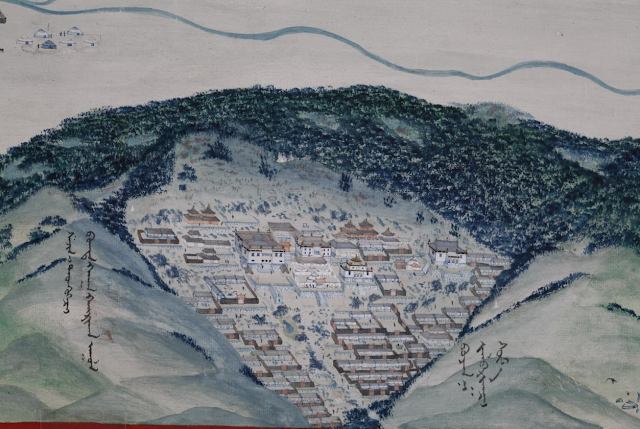Desde sempre localizada entre a rota comercial que ligava a Rússia à China, absorveu as diferenças culturais destas duas civilizações. Ainda hoje nos mercados encontramos produtos quer da europa, quer do extremo oriente.
E agora uma sucessão de representações da cidade, organizadas cronologicamente, que remontam há dois séculos atrás, para uma pequena analise cartográfica da evolução da malha urbana.
Pintura do século XIX, no centro está representado o templo Bat Tsagaan, construído em 1654.
 Mapa geral de 1851.
Mapa geral de 1851.Fotografia da área centra da cidade em 1888.

1912
Impressionante ver estas imagens da cidade de há um século atrás. E imaginar a vida da população, o interior das habitações, das yourtes, dos palácios, dos templos... Todas as imagens são excertos da pintura (4 ver lista no final).
"The large circular compound in the middle is the Zuun Khuree temple-palace complex."
"The circular compound to the far left is the Gandan complex."
"Between these two circular compounds is the Baruun Damnuurchin markets."

"The temple complex in the cross shaped fence is the Choijin Lama monastery."

"To the right of it is the mixed district of the South-East Lay Quarters (Zuun Omnod Khoroo) with the plantations."

"The Manjusri monastery can be seen on Mount Bogd Khan Uul at the bottom of the painting."
A partir daqui, começa a ser confuso, mas tens a legenda completa em baixo. [Alguma dica?]
Legenda:
E não podia faltar uma vista área mais atual da cidade Ulaanbaatar;
Links:
2- http://www.mongols.eu/maps-of-mongolia/historical-maps/
https://buddhistartnews.wordpress.com/category/mongolia/page/5/
4- http://masterpieces.asemus.museum/masterpiece/detail.nhn?objectId=11220
Para ler:
A Tour in Mongolia by Beatrix Bulstrode:
http://digital.library.upenn.edu/women/bulstrode/mongolia/mongolia.html












Sem comentários:
Enviar um comentário